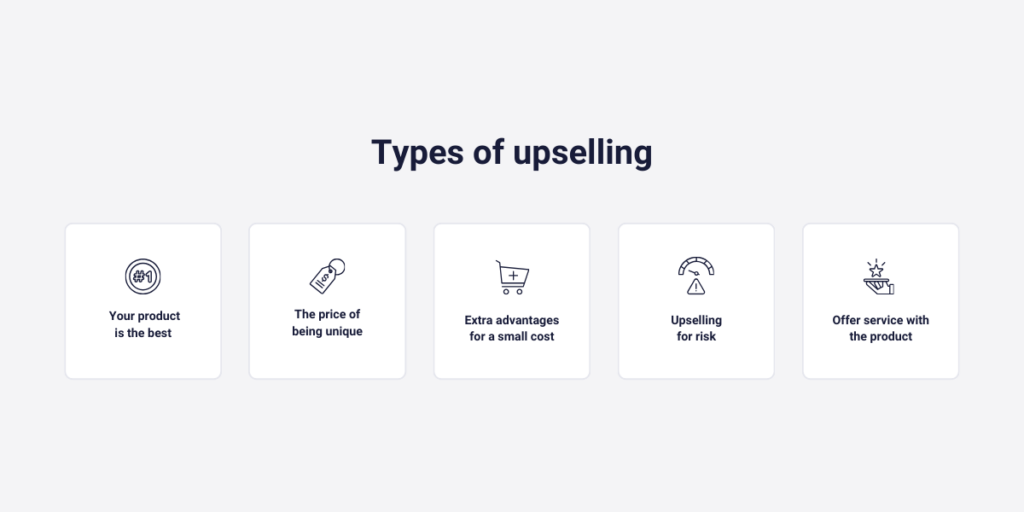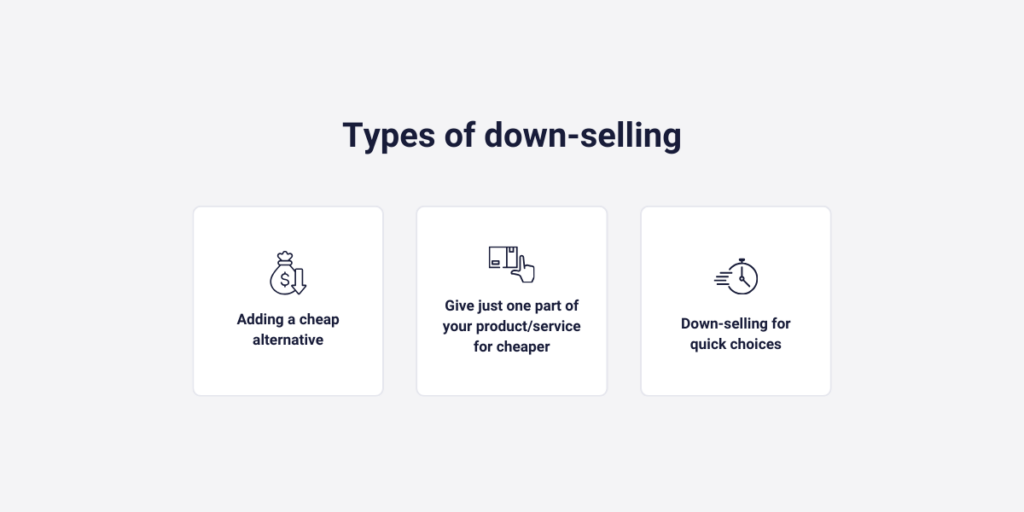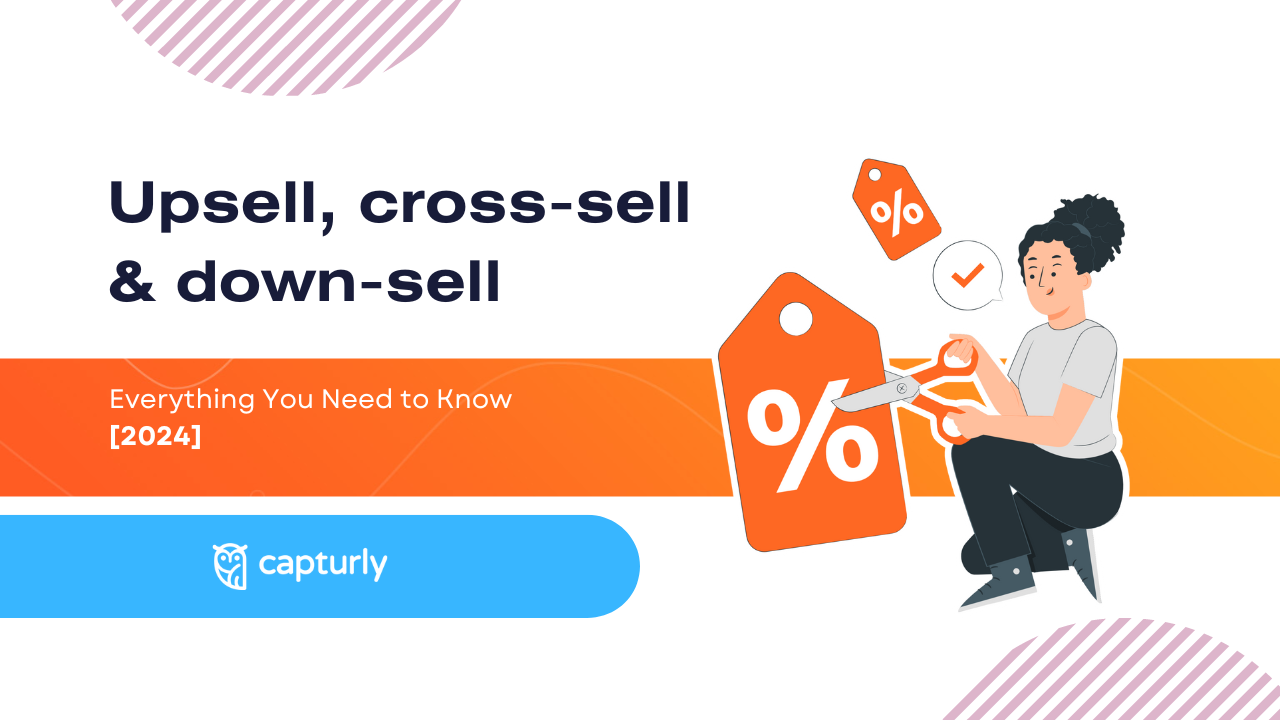If I were to ask how to make more profit for your company, most of you would say that you need to find more and more clients. Well, that’s a method. But sometimes it takes a lot of money to convince new and new buyers, more than the profit you would get after them. Or you already maximized your market capitalization, and there is no possible scenario that will bring you new buyers.
In this case, if you want to grow you have no further possibility than selling more products, or the same amount, or less, but at a higher price. Commonly, cross-selling, upselling, and down-selling all exist because of one simple reason: to get you more revenue.
Profit maximization has one crucial factor, which you always need to remember no matter what. Even as you implement strategies to increase revenue, it’s essential to ensure your customers remain satisfied. Just by reaching a better user experience, you may get an opportunity to increase your revenue, but if you do not maintain that, your customers will easily move out to your competitors without hesitation.
Are you ready to explore strategies that not only enhance user experience but also boost revenue? Let’s meet with these three marketing techniques and everything you need to know to get a full picture.
Table of Contents
What are these tactics?
These tactics—cross-selling, upselling, and down-selling—are all aimed at creating better deals for your customers. Although, without knowing their actual meanings, and the differences between them, it seems hard to understand why and how they bring you great benefits. In this chapter, we will examine the definitions of these three tactics, and understand their basics.

Cross-sell
Cross-selling means that you offer complementary products to the customer, which can satisfy other needs than the original product, so you can increase the user experience and generate more revenue. The buyer usually has no intention to buy the additional products, but well-equipped marketing campaigns can influence the buyer’s decision.
Gillette razors
The best example of this strategy, which appears in every marketing book, is the story of Gillette razors.
Gillette was not always the biggest giant of razor sellers. They were just small fish in the big ocean. How could they turn their fortunes? It was a non-conventional, but rather smart move. They realized that they could sell the razors and the blades individually.
Cross-selling does not always come with a decrease in the original product’s price, however, Gillette determined a lower price to convince the buyers to buy their razors. Although they lost money on every single razor they sold, buying the blades over and over again generated huge profits for them.
Also, the customers had no chance to compare the blade’s prices with other competitors’ prices, as almost no one sold these individually. Their model was so unique back at the time that it got a brand-new name: the razor-razorblade model. This model’s specialty is the following: sell a product at a loss but pair it with an additional product, which brings the profit.
But their story does not end here, even if it is not perfectly connected to this topic. They created a subscription model for blade refills. This provided convenience for the customers and made their profit more predictable.
And how is it a good example of cross–selling? There is an existing customer, who always chooses your main product (the razor). You offer complementary products to this customer, (in this case, create a whole strategy to separate the blades with the razor) to increase their shopping cart value.
If you create this in an efficient way, the customer will also believe it’s worth their money.
This tactic worked quite well, and by now Gillette has become one of the biggest razor retailers in the whole world.
Types of cross-selling
Let’s take a look at the types of cross-selling.
1. Bundled products
This involves offering two or more products together at a discounted price. Customers end up spending more but perceive greater value than if they were to purchase the products individually.
2. Suggested products
Commonly employed by eCommerce brands, this tactic involves suggesting additional items to customers just before they complete their purchase. By recommending products that complement what’s already in their cart, there’s a high likelihood that customers will add some of these suggestions to their cart as well.
3. Additional products
Recommend additional products to the main product. If you find the perfect communication, the buyers feel having the complementary product(s) is key for creating a better user experience on the main product.
4. Subscriptions
Many online food delivery companies utilize subscription models, offering customers the option to subscribe for monthly deliveries at discounted prices. This tactic is particularly effective for customers who make frequent purchases, as they can enjoy lower prices over time through regular subscriptions.

Upsell
Upselling means you encourage your buyers to buy a high-quality product from you (for example it contains more quality materials, healthier additives, more functions, or other add-ons), in order to increase customer loyalty and make more revenue.
It’s also important to distinguish upselling from cross-selling, as it is not always obvious which one we are talking about.
A razer (main product) + a blade (additional product) = cross-selling.
Phone (main product) + more storage capacity (extra offer) = upselling.
So in upselling, the main product will be more expensive, but provide a unique experience, while in cross-selling the complementary product brings the buyer to some extras.
Apple, the masters of upselling!
iPhone 15 for $799, or iPhone 15 Plus for $899, which one do you choose? “Definitely the second, like for the $100 price range I get the best model possible, how is it not worth it? – Many of you would think.
But the real truth is, that there is only one significant difference between these two models. The size of the phones! 15 plus is a little bigger than the 15.
Of course, they have their own explanation for the higher price:
- Little bit better battery life (none of you will experience the difference)
- Slightly more pixels (none of you would realize that)
Is it worth the $100 price difference? No, not at all! But this is the best model on the market, with some great extra functions. If this is the best, and just a little more expensive than other “good models”, I want this!
That’s the whole method behind the majority of the upselling tactics.
Types of upselling
Let’s take a look at the types of upselling.
1. Your product is the best
Create expensive products, with unique advantages.
2. The price of being unique
Let the customers customize their products for a little additional cost.
3. Extra advantages for a small cost
Offer better versions of your products (change one specific), for higher prices.
4. Upselling for risk
Sell insurance or extended guarantee as a plus function for your products for an extra price.
5. Offer service with the product
Provide a service option with the product for an additional cost.

Down-sell
Imagine a market where the likelihood of not purchasing products is high among customers. In this market, you can convince the customers to choose your company, if you sell those goods at a lower price than your competitors. It only works well, if you provide the same quality, but cheaper.
The hard part of this tactic is to calculate a price that is cheaper than your competitor’s price but covers both your fixed and variable costs. Of course, for a short period, you can work with losses, but in the long run, you need to figure out how to get more revenue.
Maybe from a mix of these three tactics.
McDonald’s, the king of down-selling
Imagine that you are going to McDonald’s with your friends. After entering the restaurant, you go to one of the electronic tables to quickly order some food. There are many options to choose from, but most food options are actually expensive, equal to those restaurant’s prices that sell more healthier food. But you come to McDonald’s to eat something, quickly and cheaply.
And your eyes get stuck on the menu options. In most European countries (we don’t have sources about other regions), McDonald’s offers a “value meal”, which usually contains two burgers, one french fries, and one customizable beverage option. This cost 4 euros, but most of the other burger menus cost at least six euros.
So university students for example with limited budgets usually choose this option, which is still worth it for McDonald’s. Of course, it is not public that selling one of these “value meal”-s, how much profit McDonalds generates, but it is almost irrelevant for two simple reasons.
Down-selling is not about generating more profit in the short run. However, it can convince price-sensitive target groups to choose you and enhance better user experience. If there are just 30 cents profits in each “value meal”, but the loyal customer buys this offer 10 times a week, it still means a lot.
Moreover, some days the buyer can’t control himself. And McDonald’s is completely aware of that activity. Down-selling, combined with the other tactics is the real deal. When you end up putting your “value meal” in your cart, even before the actual purchase, they offer you 3 other potential products, which can be great with your chosen one. This brings great benefits to McDonald’s actually.
Types of down-selling
Let’s take a look at the types of down-selling.
1. Adding a cheap alternative
As Amazon or McDonalds make, in this technique you need to recommend your customers to buy another (more cheaper) product, if they don’t want to buy their chosen product for its designated price.
2. Give just one part of your product/service for cheaper
This approach is commonly used with complex products or services. Instead of selling the entire package, companies offer individual components at a reduced cost. For example, car manufacturers may offer vehicles with optional features, allowing customers to customize their purchases based on their budget and preferences.
3. Down-selling for quick choices
This tactic is effective when you want to ensure that your customers quickly purchase something from you. Here, the company gives a discount to the customer, but it is only active for a limited time. If the user buys something immediately, the user gets a huge discount on the product’s price.

How can you import them to your own website?
Now you understand these tactics, and you can differentiate them from each other. Well, it’s progress! But we still have some topics to cover. Since implementing these tactics effectively on your own website requires careful planning and execution.
This chapter will give you advice on how to implement these tactics in the right manner.
Segment your audience
You can’t target everybody. That’s a simple law of the marketing industry. Unfortunately, implementing these tactics without segmentation can cause absolutely horrendous events. For instance, if you’re considering down-selling, target price-sensitive segments of your audience who are more likely to respond positively to discounted offers. Segmentation is also important when you want to reach these people with your messages.
Customer experience is the key
As we mentioned once, even if you find the best cross-selling, upselling, or down-selling tactic is nothing without the acceptance of your buyers. If they don’t feel like their life becomes much easier because of your new idea, it won’t work.
For example, if you sell the guitar and their strings separately, it probably won’t work. Why? It takes so much effort to put the strings up to the guitar, maybe you need some technical guidance also. If you use one of these tactics, you need to convince your buyers about the advantages of your selling strategies.
Measure, measure, and measure
You must be sure about your visitor’s thoughts before, meanwhile, and after the use of these tactics. Before implementing any changes, gather data on customer preferences, habits, and purchasing patterns. During the implementation phase, track metrics such as conversion rates, average order value, and customer satisfaction to assess the impact of the tactics in real time. Afterward, analyze the results to identify areas of improvement and refine your strategies for future campaigns.
How can data analytics tools help?
Data analytics, one of the most dynamically improved areas of the online scene, can help you make better choices on implementing cross-selling, down-selling, or upselling.
How? That’s what we will talk about in this chapter.
What is a data analytics tool?
Data analytics tool is a software that helps the company collect, store, and analyze the data connected to their user’s activity on their site. If it is used correctly, it can understand your visitors better.
The three main tools that data analytics companies provide are the following:
- Heatmap analytics – to understand where your users click, scroll, and what they read. Here, a scale with red and blue colors and its shades indicate the busy, and less busy parts of your webpage
- Conversion funnel analysis – to be sure about your individual conversion funnel’s success, and detect if one of your funnels is not converted in the usual way.
- Session recording – these data analytics tools can record your users’ individual sessions, which you can rewatch at any time. With the help of that you can find solutions to individual problems, or monitor preconceptions.
Although these are the three basic types of analytics, sometimes they offer you some more. For example, our tool, Capturly Analytics does.
What is Capturly Analytics?
Since the use of data analytics is more popular than ever, many data analytics companies appeared on the market with new methods and analysis. Capturly Analytics has been on the market for years, it was one of the first companies that tried its luck in this industry.
Our mission is to provide comprehensive analytics solutions that help our clients detect website errors, comprehend customer trends, and uncover valuable correlations between user behaviors.
Capturly Analytics also offers heatmap analytics (click, scroll, and segment), conversion funnel analysis, and a session recording tool. But that is just the beginning.
Our tool can also:
- has an analytics platform where the software highlights all the crucial information connected to funnels, or individual session recordings to see at the top the most important ones.
- has a brand new survey function, where companies can create surveys to track their user’s opinions and their behavior.
- with our session recording tool, you are not only eligible to rewatch individual sessions, rather the app labels these sessions with important notes. U-turn – when the user navigates himself to a site, but quickly goes back to the first. Rage click – when the user clicks too much to an area, most likely because of frustration. Javascript error detection – when the user faces a Javascript error, something needs to be changed in the code.
How can our tool help with introducing these selling opportunities?
Introducing these opportunities to get more revenue, increase user experience, or distinguish yourself from competitors are great potential objectives. But they don’t always work.
There can be some barriers, just as:
- It is against your customer’s expectations
- Your choice is not sustainable in the long run
- The product you sell can’t work with these tactics
You can’t solve the second, and the third problem with data analytics tools. Those require strategic planning, and the precalculations of your costs.
But, that’s not the case with the first. With data analytics tools you can understand how your users would react to a tactic like this, how they react after the actual introduction, and help you evaluate the difference in your sales, conversion, and retention rates between the first, original price, and the second price using one of these price determination techniques.
With our tool, you can:
- Segment your customers to find the best target groups for cross-selling, down-selling, or upselling opportunities
- Get access to real-time insights, and analyze how your users react to these price changes. Conversion rate, average order value, or return on investment changes; these metrics all tell you a lot.
- Create A/B testing to realize whether you need these strategies, or your customers have no intention to buy your products in these cases.
And some other potential uses are waiting for you to discover!
Conclusion
In this article, you learned the most crucial things about cross–selling, upselling, and down-selling. These methods are being part of the price determination strategies of the biggest brands, moreover, some of them grew big with the help of these methods. Since the effective implementation of cross-sell, upsell, or down-sell can be a competitor advantage for some time.
But even if it’s not, you can still win with the use of these strategies. By using them correctly, and recognizing what types of products you can upsell, or down-sell you can win two separate, but relevant things:
- better customer satisfaction, and user experience
- more sales, or at least more revenue
But do not forget: your users are real-life humans. They don’t always react to these features the same way as you want. That’s why it is important to make benefits for them also and communicate those factors that will positively affect their life due to the implementation of your strategy.
And one last thing: measure their reaction, and learn from your mistakes.
Don't forget, sharing is caring! :)



